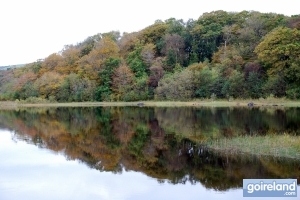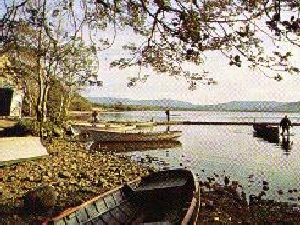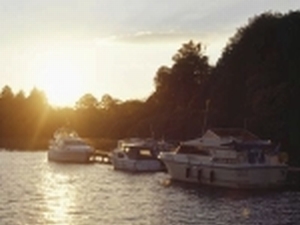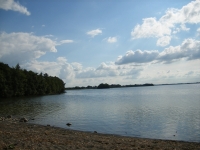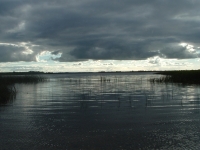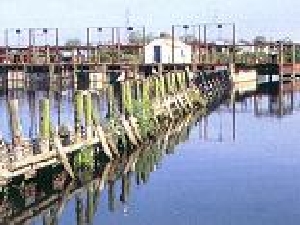From Lough Neagh in the north to the Lakes of Killarney in the south, Ireland is famous for its lakes. With everything from small pools to large bodies of water with Blue Flag beaches, Ireland has a lake to suit everyone. Pick your favourite from the selection below.
Lough Derg
Tipperary, Tipperary
Ireland’s Pleasure Lake, Lough Derg, is the largest of the River Shannon’s lakes, and is almost an inland sea. It is renowned for game and coarse angling, boating, sailing, windsurfing, and waterskiing. The shores of Lough Derg on both the Tipperary and Clare sides abound with picturesque villages, including Dromineer, Terryglass, Garry Kennedy and Mountshannon. The lake is dotted with many islands, the most famous of which is Inis Cealtra (Holy Island), which is the site of a 7th-century monastic settlement. Lough Derg is also popular for day cruises, which can be organised by cruise companies operating on Lough Derg, from Killaloe, Dromineer and Banagher. GoIreland.com has a wide range of hotels in Tipperary should you wish to book accommodation.
Fermanagh Lakes & Lough Melvin
Garrison, Fermanagh
Lough Erne extends across some 37,800 acres, with the best trout fishing area in the lower lough. The mayfly appears about mid-May and lasts until mid-June. The early season fishing in late March up to the mayfly and again in September can also be excellent.
Lough Key Forest Park
Rockingham, Boyle, Roscommon
Comprising some 350 hectares of mixed woodland, a lake and a number of islands, Lough Key constitutes one of the most extensive and picturesque landscaped caravan and camping park, including nature walks, a bog garden, observation tower, ice house, wishing chair, and underground tunnels.
The park was formerly part of the Rockingham estate and there is a wealth of historical and archaeological points of interest, principally the ruins of a McDermott castle and two medieval priorities, one on Trinity Island and the other on Church Island.
Boating, walking trails and a restaurant are some of the amenities in this fine park which is situated on an island studded lake of great beauty.
Lough Ennell & Lilliput
Mullingar, Westmeath
This lough’s extensive feeder streams ensure a good stock of wild brown trout averaging 2 lbs. 2 ozs. in weight.
The peak of the brown trout fishing is from early August until the end of the season. Why not spend a night or two in the area? Book from GoIreland’s list of quality Mullingar hotels.
Lough Ree
Roscommon, Roscommon
Lough Ree is a famous coarse angling lake, 28km long and the second largest lake in the Shannon system. The lake is noted for its big pike. Lough Ree produces specimen bream, tench, hybrids and rudd each year. Bags of mixed coarse fish to 100Ibs are common for a day’s fishing.
Lough Derravaragh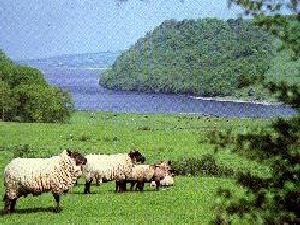
Castlepollard, Westmeath
Lough Derravaragh is the most majestic of the Westmeath lakes at 8.04 km long. It offers good fishing for trout, pike, and perch, and its steep wooded shores set against a background of rolling grassland provide a memorable view. The lake is associated with the most tragic of all Irish legends: the Children of Lir, who were changed into swans by a jealous stepmother and spent 300 years on its dark waters.
Lough Neagh Eels
Antrim, Antrim
The 4,000-year-old tradition of eel fishing continues to thrive on Lough Neagh, with many local communities dependent upon the harvesting of the eels. The eel’s life cycle begins when the tiny elvers set out from the Sargasso Sea on a mammoth journey to the mouth of the River Bann near Coleraine. During the final leg of their journey downstream to Lough Neagh many of the maturing brown eels are caught by local fishermen using traditional methods. The surviving eels remain in the lough and at around 12-14 years old they turn silver and are once more compelled to return to Sargasso Sea to spawn and die. Lough Neagh eels are considered a delicacy and while some are served in local establishments, the majority are exported to London, Germany and Holland.
Lough Gur
Killmallock Road, Limerick, Limerick
Lough Gur is the site of a Neolithic settlement inhabited in 3000 BC, and the Lough is surrounded by ancient standing stones, burial mounds, megalithic tombs, and perhaps most impressively, a 4,000-year-old stone circle just outside the park. A mock Stone Age hut houses an interpretative centre with audiovisuals and models to help visitors understand what archaeologists have learnt from the settlement. Castles from the 13th and 15th century are reminders of the lake’s more recent history. Check out some of GoIreland’s Limerick hotels if you are looking for quality accommodation in the vicinity.
